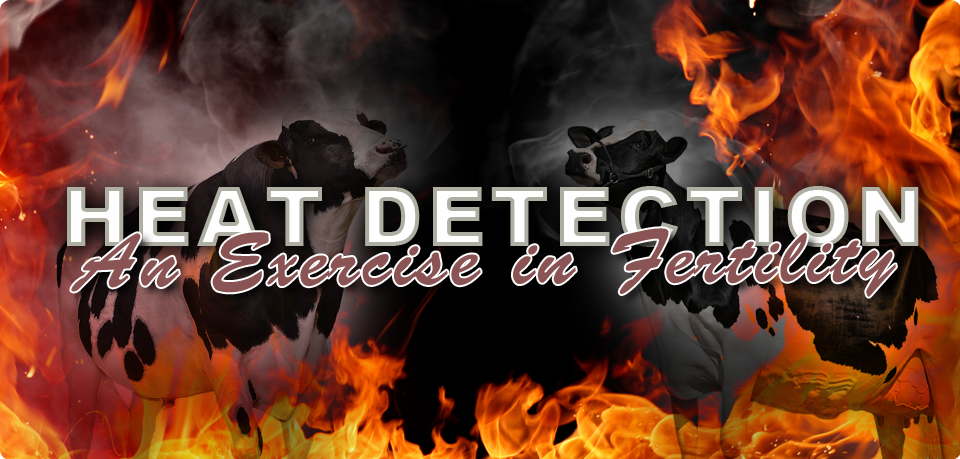Milk is only Part of the Equation
When it comes to what we have learned about raising and managing dairy cows, you could make milk production a study all on its own. In many ways we have done exactly that. We have spent so much of our focus on selecting genetics for improved milk production, that now we have fertility issues. You don’t have a profitable dairy farm if you leave out that ability to cycle reproductively, breed successfully and put healthy calves safely on the ground. These are three vital components to a dairy cow’s productive performance. Focusing on milk has, over time, disrupted the cow’s ability to do these foundation steps successfully. Today’s cow is out of balance. We need to get back to the basics. Which starts with getting pregnant. Which starts with detecting heats.
The Heat is On. We’re not making the grade.
Heat detection is the most important factor in determining the number of pregnancies a herd produces in any period of time. Anything, and everything, you put into being more effective in this area will result in your herd achieving higher fertility ratings. Herd statistics, farm profitability and reproductive efficiency are seriously affected by the level of effectiveness of estrus detection. The report card from farm to farm varies widely and many are not achieving high marks here. You have to realize it’s still zero whether you miss the pregnancy through fertility or mismanagement.
Do your Homework.
Five ways to affect your heat detection are:
- Watch their Behavior: Activity measures of estrus. Use observances, pedometers or accelerometers.
- Measure their Hormones: Hormone levels such as progesterone can be detected in blood and also in milk.
- Take their Temperature: Changes temperature indicators can be measured in milk and vaginal mucous.
- Veterinary Diagnosis: Go to the experts and use palpation or ultrasound scanning.
- Synchronize Them: Take out the variable of missed estrus by using a fixed time insemination.
Fertility 101. Get it right every time. Go to the head of the class.
Developing excellent visual heat detection technique can make your herd a lot of money – if you can correctly identify the signs of estrous. If a cow shows three or more of the following signs, there is a good chance she could be in heat.
- Standing and mounting behavior
- Bawling
- Head butting
- Chin pressing
- Butt sniffing
- Bright, alert appearance
- Reduced appétit
- Lower milk yield
- Swollen vulva
- Mucus discharge
Early morning, noon and late evening observations for 20 minutes each are necessary to observe more than 90 percent of the heats in a herd. During hot weather, watch animals earlier and later each day. During cool weather, the middle of the day is generally the best time to watch. Grouping cows that are ready for breeding or recently bred is another way to make the best use of observation time.
Cows tend to be more active on dirt or pasture and should be watched for heat activity while off concrete surfaces. Increased activity will not occur in cramped cubicles or on slippery surfaces. Also, carefully watch cows the first 30 minutes they are turned out to pasture or an exercise lot. Activity is low during feeding and milking times.
Report Card: Don’t manage to “fail”
Use a test to diagnose pregnancy. There are accuracy differences and challenges with each method. Here are three:
- Ultrasound
- Palpation
- Blood based pregnancy test
Do you know the rate at which your heifers become pregnant? Under poor reproductive management the service rate is 40 percent and a conception rate of 50 percent. By contrast, the rate at which heifers become pregnant under excellent reproductive management measures out at a service rate of 90 percent and conception rate of 70 percent. The 40 percent service rate means 20% are in calf. The 70 percent service rate means 63% are in calf. In any classroom, a difference of 43% is humongous or, as the teacher would say, huge!
Although the average age at first calving can be 25.4 months for the poor-management group of heifers, more than 25 percent of the heifers will not calve until after 26 months of age and 10 percent of the heifers will not calve until after 28 months of age. Clearly, the average age at calving is not truly reflecting an underlying reproductive problem. But, more important, 95 percent of heifers subjected to excellent reproductive management will calve before 25 months of age!
Economics also supports the fact that you must improve results in this area. If each day open costs around $3-$4, then each heat missed costs $63-$84. And, remember semen, drugs and extra labour costs are over and above that $3-$4 per day. This can be very costly in a herd of dairy cows. Catching heats is the first step to getting animals bred.
The Bullvine Bottom Line
None of the preceding information is new to people who work with dairy cows but obviously we forget to put it into practice. Practice makes perfect. Heat detection makes profit. Go to school on your herd.

















Leave a Reply
You must be logged in to post a comment.